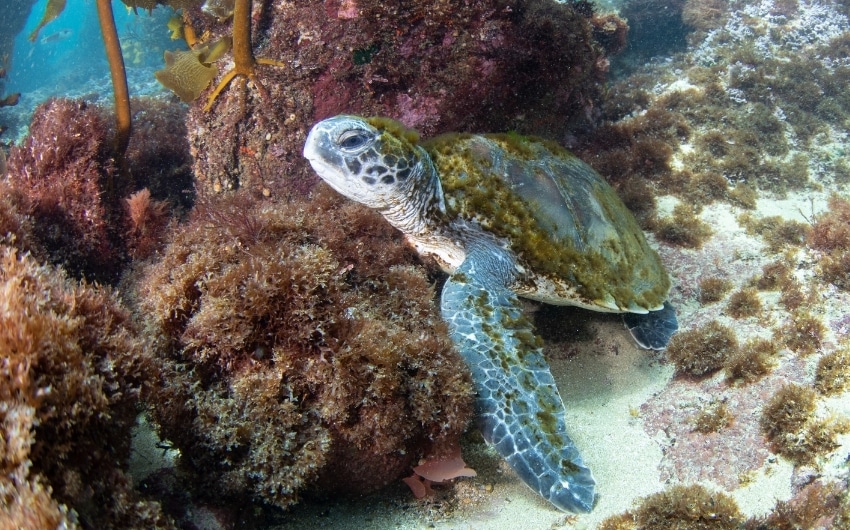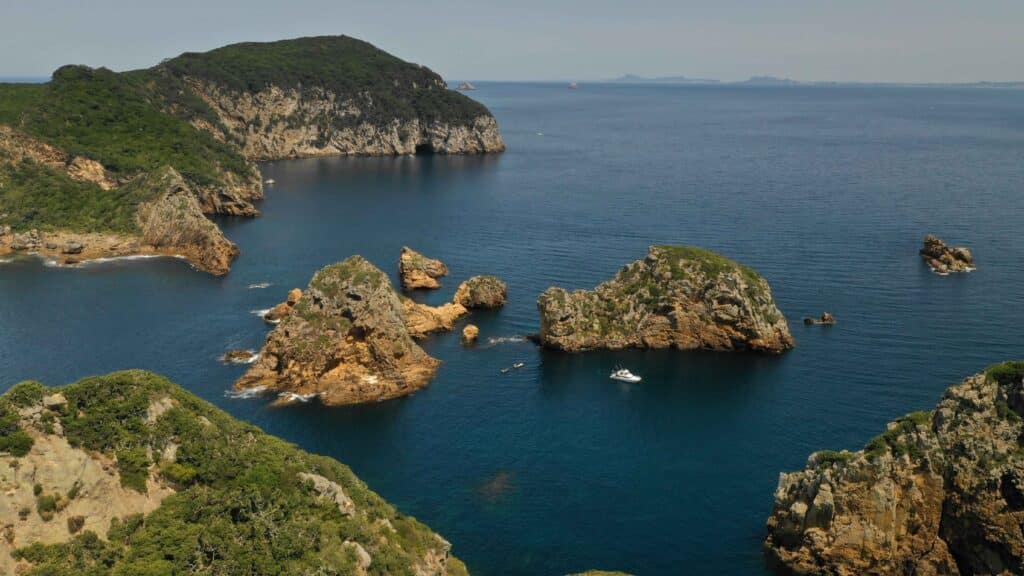
Ngāti Wai and Rawhiti Rahi.
The Ngāti Wai iwi (tribe), whose rohe (tribal area) spans the northeastern coast of the North Island, including Whangārei and the surrounding coastline, were the tangata whenua (original people) of the Poor Knights Islands — known in te reo Māori as Tawhiti Rahi (the main island) and Aorangi (the smaller island).
The islands were home to 300 to 400 people for several generations, but it is impossible to know when they first arrived at the islands.
These islands were more than just a home — they were a stronghold, a sanctuary, and a taonga (treasure). Their isolation from the mainland gave the people who lived there a degree of safety from mainland conflict, and the surrounding waters were teeming with kai moana (seafood) like kina, pāua, crayfish, and fish.
They built pā (fortified villages) atop the cliffs of Tawhiti Rahi, and if you were allowed onto the islands, you would be able to still see signs of these settlements today — terraces, storage pits, and middens left behind.
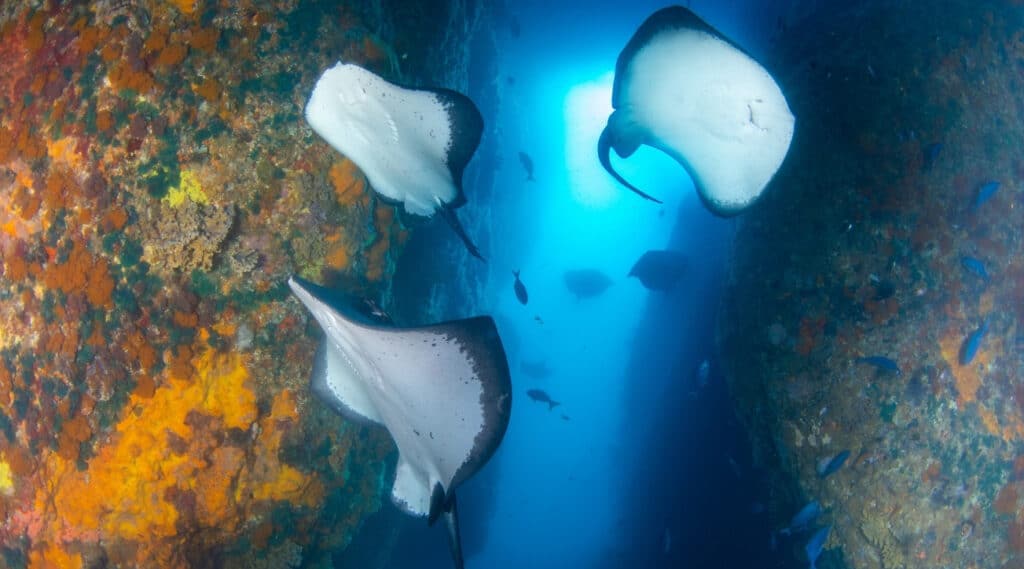
Growing crops and catching food
Archaeological evidence and oral traditions suggest that Māori living on Tawhiti Rahi and Aorangi cultivated traditional Polynesian crops, just as they did on the mainland. The most likely crops grown on the Poor Knights include:
Kūmara (sweet potato):
This was the most important cultivated crop. Kūmara thrives in well-drained, sunny areas, and the volcanic soils of the Poor Knights would have made for decent growing conditions.
Māori used stone rows and mounds to help manage warmth and water retention, especially on islands where the climate could be a bit more exposed.Taro (Colocasia esculenta):
While more common in warmer, wetter parts of Polynesia, taro may have been grown in small sheltered areas with good water access.Gourds (Hue):
Grown for use as containers, not food. Hue (bottle gourds) were dried and used to carry water or store food and valuables.Other plants:
They likely grew harakeke (flax) for weaving and karaka trees, whose berries were a traditional food (though toxic if not properly prepared). Karaka is still found on the islands today.
How They Farmed
There are still visible signs of old garden terraces and stone field systems on the islands — built to create level planting areas, protect soil from erosion, and trap warmth from the sun. These methods are typical of traditional Māori horticulture in exposed coastal environments.
They likely used seaweed and fish scraps as natural fertiliser, which was common practice to enrich the soil.
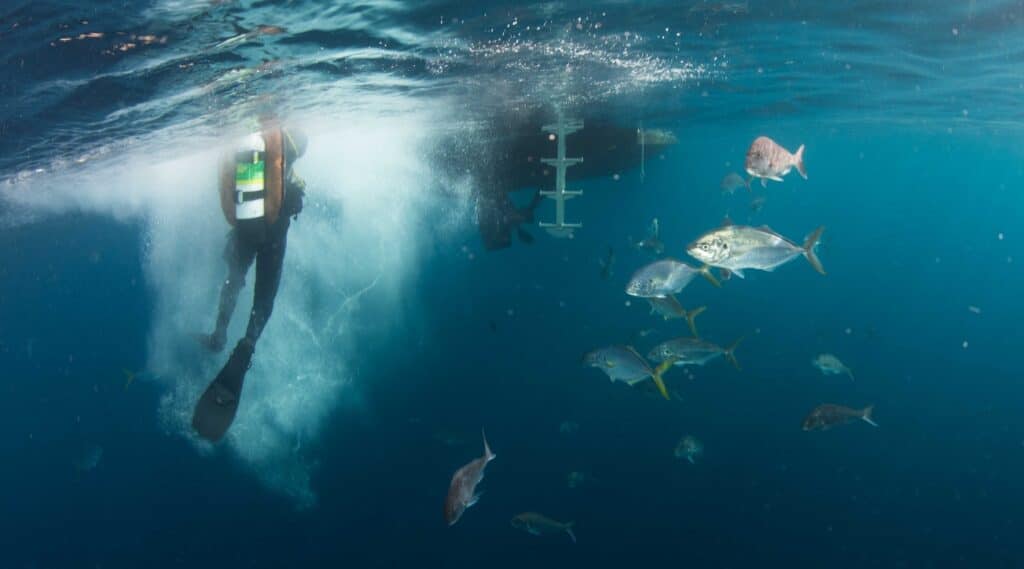
Muttonbirds
The term muttonbird in New Zealand usually refers to young sooty shearwaters (tītī), but at the Poor Knights, the Buller’s shearwater (rako in te reo Māori) was the dominant seabird. These birds nest almost exclusively on Aorangi Island, one of the two main Poor Knights Islands. In fact, Aorangi holds the world’s largest colony of Buller’s shearwaters, making it a taonga (treasure) species — ecologically and culturally.
Māori living on the islands would have harvested young rako chicks during the breeding season, likely in late summer to early autumn, when the chicks were still in their burrows but almost fully grown — rich in fat, easy to catch, and perfect for preserving.
How They Were Harvested and Eaten
Chicks were extracted from their nesting burrows, which riddle the ground in huge numbers.
Birds were plucked, cleaned, and preserved, often in their own fat, and stored in containers such as pōhā (kelp bags) or wooden vessels.
This preservation method allowed the meat to be stored for months — perfect for hard times or trade.
Muttonbirds are known for having rich, oily flesh, which not everyone enjoys today — but to Māori, they were a nutrient-dense delicacy and a symbol of seasonal abundance.

Kai Moana
The people of Ngāti Wai who lived on Tawhiti Rahi and Aorangi likely targeted:
Snapper (tāmure) – abundant in the area and a prized food fish.
Tarakihi, trevally, and kahawai – common in coastal and reef areas.
Kingfish (haku) – powerful predators often found near pinnacles and drop-offs.
Butterfish (marari) – often speared or trapped in kelp areas.
Crayfish (kōura) – plentiful in the rocky reef systems.
Pāua (abalone) – found clinging to rocks in shallows.
They also gathered kina (sea urchins), shellfish, and other reef-dwelling invertebrates.
How They Fished
Māori had a deep understanding of tides, fish behaviour, and seasonal movement. Their fishing methods included:
Handlines and hooks made from bone, shell, and wood (later metal when it became available).
Nets (kupenga) woven from harakeke (flax), sometimes weighted with stones.
Fish traps and weirs, although large-scale ones were more common in estuarine environments.
Spears and diving – freediving for kai moana was common in shallow reef systems.
Rock fishing from ledges around the islands — which you can imagine being perfect spots even today.
They also used lures for pelagic fish, often beautifully crafted with pāua shell inlays to reflect light and mimic baitfish.

The Musket Wars and the Tapu of the Islands
In the early 1800s, during the height of the Musket Wars — a period when intertribal warfare dramatically escalated due to the introduction of muskets — the islands became the site of a devastating massacre.
Ruled over by a chief called Tatua, although dependent on trade with the mainland for obsidian, and some timber, they were very self-sufficient and even had pigs on the island which are said to have come from Captain Cook as he passed by in 1769. The pigs were kept in stone sties, and were the main item of barter to tribes on the main land.
In the very early 1800’s, (estimated 1808), Chief Waikato from the Hikutu tribe on the west coast in Hokianga, paddled all the way over on his waka to trade with Tatua.
For a reason unknown, Tatua decided against selling his pigs to Waikato and so the Hokianga crew paddled away, not being allowed onto the islands empty handed. This was an insult that was not to be forgotten and Utu {revenge) was declared. The concept of utu doesn’t necessarily focus solely on the individual who caused the action; it can affect the entire group involved and could escalate over time, with reciprocal acts intensifying as the relationship developed over generations.
Around 1820-23, Chief Waikato got his Utu when he led his warriors on a journey of 320 km, after hearing from an escaped slave named Paha that the islands were undefended. Tatua had taken his warriors south to join Hongi Hika on a fighting expedition to the Hauraki Gulf 150km south.
The people of the Poor Knights were ambushed and slaughtered, their community destroyed almost overnight. Tatau’s wife Oneho and her daughter were taken as prisoners. But on the journey back to the Hokianga Harbour, the two captives escaped and made their way to Rawhiti.
When Tatau returned back to the islands, he was met by the only ten survivors, including his five year old son Wehiwehi, who was saved by old man Omanoa who hid him in a small cave.
Totally demoralised, the warriors performed last rites over the slain and then declared the islands to be strictly tapu, sacred and forbidden.
The idea was both spiritual and cultural: out of respect for the dead and due to the belief that the islands were now imbued with powerful wairua (spirit), the survivors never returned to live there.
To this day, the tapu remains. Ngāti Wai do not allow landing on the islands without permission, and even now, most visitors (including divers and tour operators) respect the sacredness by staying on the water and not setting foot ashore.
The highest peak on Aorangi is named after Tatua’s wife Oneho,

Spiritual Connections and Guardianship
For Ngāti Wai, fishing wasn’t just survival — it was woven into their identity. The ocean was seen as a living ancestor, a taonga, and a provider. Ngāti Wai, whose name literally means “people of the water,” were known as sea people — skilled navigators, fishers, and gatherers.
The Poor Knights would have been a rich, sacred centre of that life and they are still watched over. They are seen as the realm of the ancestors, and the iwi maintain a spiritual connection to them.
The islands are considered wāhi tapu — sacred places — and are under the guardianship of the iwi.
In many ways, Ngāti Wai have become kaitiaki (guardians) of the Poor Knights, working alongside DOC (Department of Conservation) to preserve the islands’ ecosystems and cultural history.

European Exploration & Naming
The name “Poor Knights” is believed to have been given by Captain James Cook or early European sailors. One theory is that the name refers to a dish popular at the time—Poor Knights pudding, a kind of French toast. It’s possible the islands reminded sailors of the dish, perhaps due to their shape or the way the sun hit the cliffs.
Another is that the islands seen from afar, look like a dead knight laying on the ground with his shield across his body. Poor knights were buried where they were killed, covered by a layer of soil or stones. Rich knights were taken back to europe for grandeur burials.
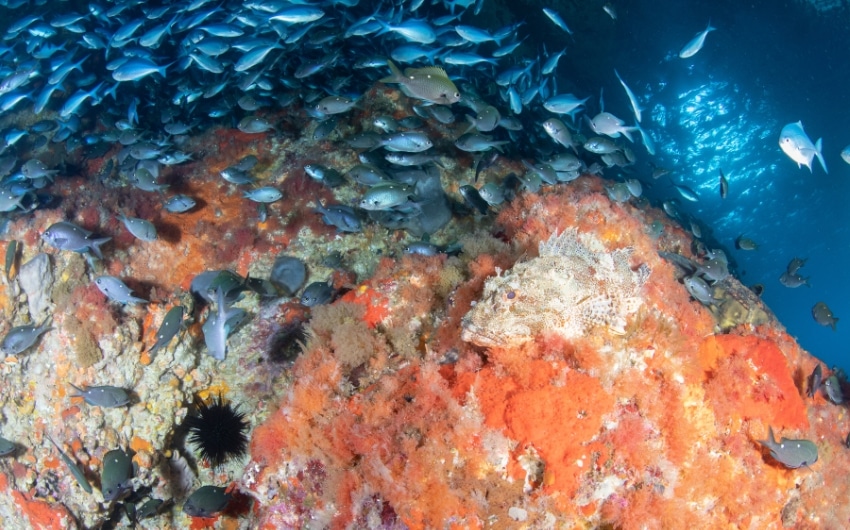
Modern History & Conservation
World War II
There are rumours of a Japanese submarine that hid in Rikoriko cave for 2 weeks whilst repairs were made. There was certainly enemy activity in the area. 228 enemy mines where laid on the 13/14 June 1940 in the Hauraki gulf by German Ship HKS Orion and these claimed two Allied ships; RMS Niagra on 19 June 1940 and the HMS Puriri the following year on 14 May 1941.
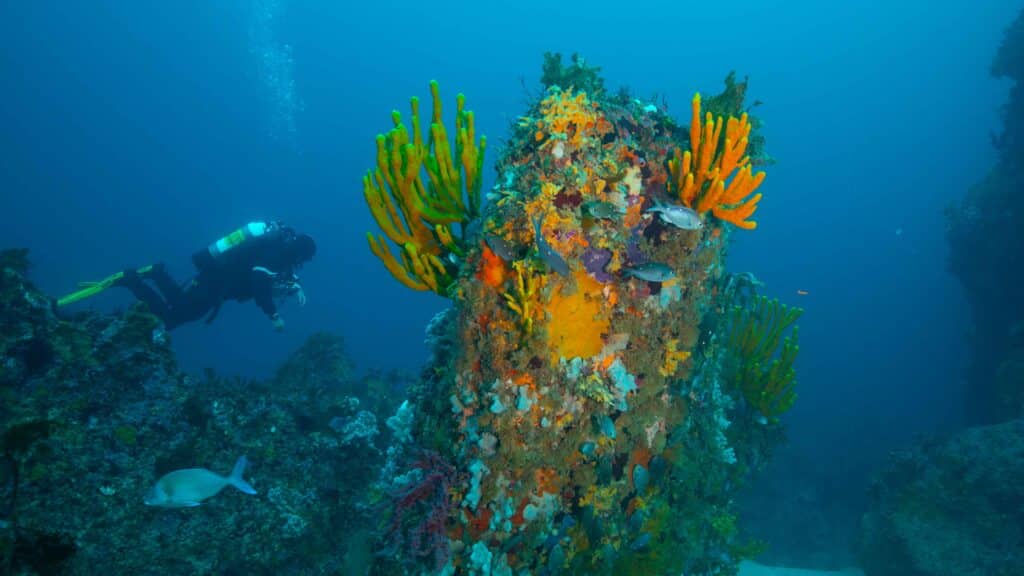
New Zealand Diving royalty
It’s such a cool part of New Zealand diving history. The Poor Knights were legendary long before scuba gear arrived, but it was a group of passionate local divers in the 1950s and ’60s who truly opened the underwater world to the rest of us.
The Original NZ Scuba Divers at the Poor Knights
After WWII, scuba technology started reaching New Zealand — mostly ex-military gear, cobbled together by keen Kiwis who were curious about what lay beneath the waves. One of the first places they explored in depth was the Poor Knights Islands.
Key Pioneers
Wade and Jan Doak – Probably the most iconic names. Wade was a biologist, diver, photographer, and ocean advocate. He and Jan began diving the Poor Knights in the 1960s, and Wade spent decades studying, photographing, and promoting marine life there.
Kelly Tarlton – Yes, that Kelly Tarlton — the man behind Auckland’s famous underwater world. He was also an early diver and explorer of the Poor Knights, working with others to document its incredible biodiversity.
Bill Palmer and Peter Blake (and others from early clubs like the Auckland Underwater Club) – Some of the first to do proper underwater exploration at the Knights.
They were part of a generation that discovered the magic of the Poor Knights’ underwater arches, tunnels, and drop-offs — all before marine reserves, GPS, or modern dive boats.
What They Found
Huge schools of fish
Crayfish so abundant you could pick them up
Bright sponges, nudibranchs, gorgonian fans, and soft corals
Subtropical species like lord howe coralfish and ray’s bream, thanks to the East Auckland Current
Their excitement was infectious — they took photos, gave talks, wrote books and articles — and helped make the case for protecting the area.
Protecting the Poor Knights
Thanks in part to the passion of these early divers, the Poor Knights became:
A Marine Reserve in 1981 (no fishing or collecting in core areas)
A fully protected no-take zone in 1998, making it one of the most successful marine reserves in the world
Dive History in a Nutshell
“In the ’60s, when a bunch of Kiwi divers strapped on some early scuba tanks and headed out to the Poor Knights, they had no idea they were about to discover one of the ocean’s hidden gems. Wade Doak and others found a sub-tropical paradise bursting with life — and their love for it helped get the place protected forever.”

World class recognition
Jacques Cousteau, the legendary French ocean explorer, visited the Poor Knights Islands in the early 1970s — and he was blown away by what he saw.
After diving there, Cousteau famously declared the Poor Knights to be:
“One of the top 10 dive sites in the world.”
That one quote helped put the Poor Knights on the global map for scuba divers. Even today, it’s often mentioned in dive magazines, documentaries, and tourism blurbs.
While the exact date of his visit isn’t widely published, most sources place it around 1971–1972, during a period when Cousteau was traveling the world aboard his iconic research vessel, Calypso, filming for “The Undersea World of Jacques Cousteau.”
Back then, the Poor Knights wasn’t a marine reserve yet — but Cousteau’s praise helped spark increased awareness and appreciation for the biodiversity and uniqueness of the site.
The islands were gaining fame not for human habitation, but for their exceptional marine life. In 1981, they were declared a marine reserve, and in 1998, the surrounding waters became a fully protected no-take zone. The islands themselves are also a nature reserve, home to rare plants, birds, and reptiles.
Today, the Poor Knights Islands are a UNESCO World Heritage Tentative Site and are internationally recognised as one of the world’s top diving and snorkelling locations, thanks to their stunning underwater landscapes and rich biodiversity.
They showcase the benefit the protection a marine reserve provides an area. Showing not only New Zealanders, but people from all around the world, how healthy the local waters could be like if the pressures from fishing and other human activities were limited or removed.
